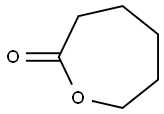
Polycaprolactone
- русский язык имя
- английское имяPolycaprolactone
- CAS №24980-41-4
- CBNumberCB9498981
- ФормулаC6H10O2
- мольный вес114.1424
- EINECS244-492-7
- номер MDLMFCD00084404
- файл Mol24980-41-4.mol
химическое свойство
| Температура плавления | 60 °C(lit.) |
| плотность | 1.146 g/mL at 25 °C |
| Tg | -60 |
| температура хранения | -20°C |
| форма | pellets |
| Запах | odorless |
| Вязкость | 400-1000mPa.s50wt. % in xylene |
| InChI | InChI=1S/C6H10O2/c7-6-4-2-1-3-5-8-6/h1-5H2 |
| ИнЧИКей | PAPBSGBWRJIAAV-UHFFFAOYSA-N |
| SMILES | O1CCCCCC1=O |
| Система регистрации веществ EPA | 2-Oxepanone, homopolymer (24980-41-4) |
| UNSPSC Code | 41116100 |
| NACRES | NA.23 |
| WGK Германия | 3 |
| RTECS | TR4708000 |
| TSCA | TSCA listed |
| кода HS | 3907998090 |
рисовальное письмо(GHS)
-
рисовальное письмо(GHS)

-
сигнальный язык
предупреждение
-
вредная бумага
H315:При попадании на кожу вызывает раздражение.
H319:При попадании в глаза вызывает выраженное раздражение.
H335:Может вызывать раздражение верхних дыхательных путей.
-
оператор предупредительных мер
P261:Избегать вдыхания пыли/ дыма/ газа/ тумана/ паров/ аэрозолей.
P271:Использовать только на открытом воздухе или в хорошо вентилируемом помещении.
P280:Использовать перчатки/ средства защиты глаз/ лица.
Polycaprolactone химические свойства, назначение, производство
Химические свойства
intrinsic viscosity 1.00-1.30Использование
Extrusion aid, die lubricant, mold release, pigment and filler dispersion aid and polyester segments in urethanes and block polyesters.Свойства и приложения
Polycaprolactone (PCL) is a biodegradable, semicrystalline polyester for use in tissue engineering and drug delivery research applications. Due to the increased length of the aliphatic chain, polycaprolactone degrades significantly slower than other common biodegradable polymers, such as polylactide. PCL features a low melting point (55-60 °C), making it ideal for thermal processing and increasing its use in novel applications such as 3D bioprinting. In addition to its favorable thermal properties, PCL also features high solubility in organic solvent allowing for a multitude of other processing options. This product features low residual water, monomer, and catalyst (tin) making it an ideal choice for use in tissue engineering and 3D bioprinting research.Профиль реактивности
Polycaprolactone (PCL) is biodegradable polyester with a low melting point of around 60 °C and a glass transition temperature of about 60 °C. PCL is prepared by ring-opening polymerization of ε-caprolactone using a catalyst such as stannous octanoate[1]. Polycaprolactone is a semicrystalline linear polyester produced by ring-opening polymerisation of epsilon-caprolactone, which is commonly derived from fossil carbon. It has a much lower glass-transition temperature (Tg = ? 60 °C) than other biodegradable polymers, which assists its biodegradability despite its high degree of crystallinity, typically 50%[2].Polycaprolactone поставщик
| поставщик | телефон | страна | номенклатура продукции | благоприятные условия | |
|---|---|---|---|---|---|
| +86-852-30606658 | China | 43340 | 58 | ||
| +86 13288715578 +8613288715578 |
China | 12825 | 58 | ||
| +8617531153977 | China | 5855 | 58 | ||
| +86-13131129325 | China | 5887 | 58 | ||
| +86-86-4001020630 +8619831957301 |
China | 1000 | 58 | ||
| +8617732866630 | China | 18147 | 58 | ||
| +86-15532196582 +86-15373005021 |
China | 3007 | 58 | ||
| +86-371-86557731 +86-13613820652 |
China | 20259 | 58 | ||
| +8613343047651 | China | 3692 | 58 | ||
| +8615373025980 | China | 895 | 58 |